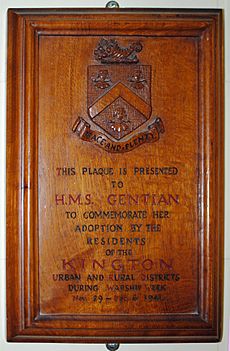Warship Week facts for kids
Warship Weeks were special campaigns in Britain during the Second World War. Their goal was to encourage people to save money so that towns and cities could "adopt" a Royal Navy warship. This meant the community would raise enough money to help pay for a ship, and then they would form a special connection with its crew.
During the early part of the war, Britain's navy had lost many large ships. They also needed more ships to protect other vessels carrying supplies across the Atlantic Ocean. Even though there were enough sailors, new ships were needed to replace those that were sunk by enemy attacks.
Similar campaigns were held for other parts of the military. The British Army had "Salute the Soldier Week," and the Royal Air Force had "Wings for Victory Week."
Contents
How Did Warship Weeks Work?
Communities Adopted Ships

Each community was given a target amount of money to save. This money would help cover the cost of building a specific type of naval ship. Big cities aimed to raise enough for huge ships like battleships and aircraft carriers. Smaller towns and villages focused on ships like cruisers and destroyers. Even smaller places had lower targets. Once a community reached its goal, it would officially "adopt" the ship and its crew.
Local groups, churches, and schools often made things like gloves, woollen socks, and hats for the sailors on the adopted ship. Children would also write letters and send cards to the crew. Sometimes, officers and sailors from the adopted ship would visit the community that supported them. Often, a parade would be held to celebrate their visit.
The ship's commanding officer would exchange special plaques, objects, and photos with the town or city that met its savings goal. This marked the start of their "adoption." Over 1,200 warships were adopted, including battleships, cruisers, destroyers, and even smaller boats like trawlers.
A National Savings Effort

Between 1941 and 1942, the British government started the idea of "National Savings." Each area in the country was given a savings target. This target was based on how many people lived there. Different levels of savings were linked to different types of warships. This campaign became known as Warship Week. It was similar to "War Weapons Week," which was a drive to replace military equipment lost during the Battle of Dunkirk through savings.
How Successful Were They?
The Warship Week campaign lasted for 24 weeks and raised a huge amount of money for the government. The total was over £955 million! This included more than £545 million raised specifically during the weeks named Warship Weeks.
Communities helped sponsor ships by encouraging people to buy government bonds and national savings certificates. The campaigns were organized by the National War Savings Committee, with help from the Royal Navy. In total, 1,178 Warship Weeks were held, involving 1,273 different districts. News reports at the time said that communities adopted eight battleships, four aircraft carriers, 49 cruisers, 301 destroyers, 25 submarines, 164 corvettes and frigates, and 288 minesweepers.
See also
- British Home Front during the Second World War
- National Savings and Investments

